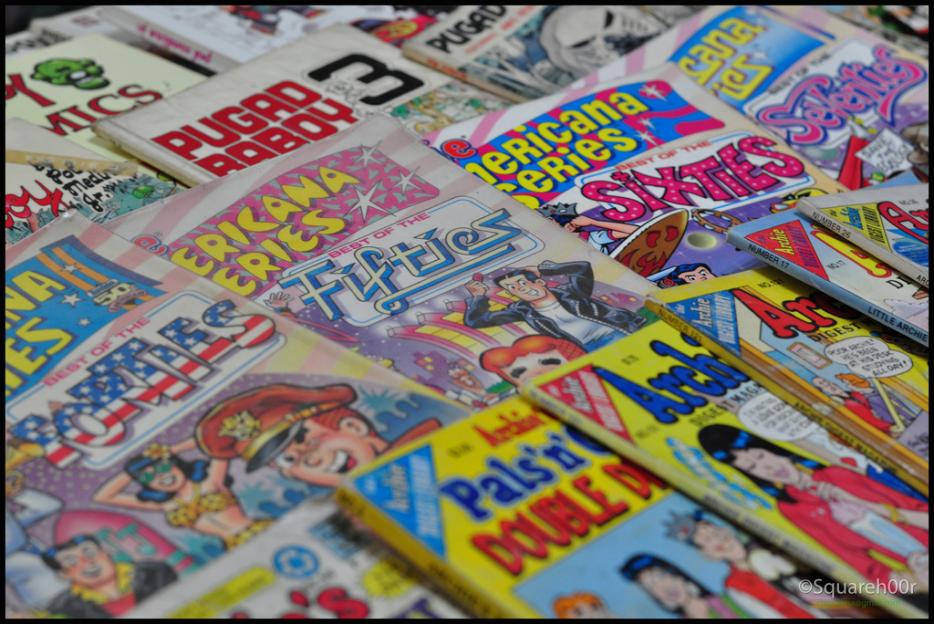I don’t remember the first Archie comic I read, and the publisher probably prefers it that way. Nothing in Riverdale could be too memorable. In the ubiquitous digests we grabbed from checkout counters or passed around daycare, it was common to find decades-old stories; every Moose clobbering and romantic intrigue existed outside of history. Even then, I think we sensed that Archie’s signifiers of youth—the malt shop, the sweaters—were social details that faded away around the same time as the Eisenhower administration. Sometimes the characters didn’t really resemble high school students at all: Jughead carried himself like a 33-year-old disinclined to graduate, and several freelancers drew many, many, many underage girls mimicking the pin-up art they also dabbled in. Roland Barthes once decoded a pasta advertisement in terms of Italianicity, which “is not Italy but the condensed essence of everything that could be Italian, from spaghetti to painting.” The bizarre tangles of anachronism in those Archie digests were foreign to any actually existing teens I met, just as no nonna cooked Barthes’s pasta, yet they still evoked a certain adolescentness.
Think of Jughead’s hat. It was a product of his early-1940s origins, during a brief vogue for beanies, inverted fedoras with the brim scissored into patterns. The Jughead version became steadily more stylized, turning eventually into a floppy grey crown, always with the same two buttons in the same order. A hat that once fell into the long Archie tradition of fitfully hugging any passing fad was decontextualized to mark the character’s individualism, as much a part of him as his laconic saunter, insatiable appetite, and discomfited fear of kissing. (No wonder so many kids decided Jughead was their favourite character.) Other featured players sit closer to existing archetypes: Veronica’s bored and magnificent cruelty could be delivered by Claudette Colbert, while the spluttering Mr. Lodge is a comic type dating back to Edwardian farce, if not earlier. When the Archie crew showed up on The Simpsons, their very presence in the modern world was the non-sequitur.
In his new book, Twelve-Cent Archie, Bart Beaty argues that Riverdale is a “story-generating machine,” feeding narrative prompts through a small and settled cast to produce endless content. Marvel and DC reboot entire fictional universes to clear away the weight of past events, even Doonesbury characters age, but Betty’s longing will never be requited for more than a single page. The classic Archie comic doesn’t just refuse serialization—beyond their most established traits, there is no continuity in the characters either. (Being the kind of evil jerk who inexplicably remains everyone’s friend, Reggie often provides an elastic catalyst.) Archie alternately plays the dutiful suitor and a feckless, maladroit idiot, depending on what will cause the most mayhem. Noting that two adjacent strips portray him as both a C student and fluent polyglot, Beaty asks: “Why is Archie so good at French and so poor at English? Why does he never speak French in any other comic of the entire era? Does Riverdale High even have a French teacher?”
Twelve cents is how much Archie comics cost throughout the 1960s, the era on which Beaty focuses. The period seemed to him a creative and commercial peak; in 1967, the flagship Riverdale titles far outsold Stan Lee and Jack Kirby’s Fantastic Four. The University of Calgary professor struggled to discover any previous scholarly work on Archie, which did not surprise me. Whether academic or generalist, comics criticism prizes literary auteurs (the metafictional graphic novel) and pulp ripe for exegesis (Superman as immigrant). Jughead et al are popular in an uncool way, too prolific for camp re-appropriation. But if we believe in the significance of mass culture, that Earth’s orbit alters when enough feet land at once, we shouldn’t dote on Elvis and then scorn a Pat Boone. Even the art you hate or find unbearably tacky has emotional histories trailing after it. I’ve been guilty of this myself, ignoring the typical for the exceptional—a distinction one can never maintain for long anyway, when strange sights often hide amidst familiar landscapes.
The format of Twelve-Cent Archie was inspired by its topic. Beaty divides his gently post-structuralist study into a hundred short chapters or angles or close readings, covering everything from bowling to juvenile delinquency, small pieces of a larger system. You can place them in any order. Also like his subject, Beaty occasionally strains to fill space—one passage compiles every spelling error he found during his survey. But the rabbinical examination reveals all the formal invention in these comics, whether wordless experiments or the diagonal-oval symbols that radiate from a nonplussed character (Archie fan Jaime Hernandez adopted the effect in Love & Rockets). Beaty analyzes the source material with mordant detachment: “Veronica’s central problem is that she hates the only friend that she has.” He makes Riverdale High’s insincerity, violent jealousy and Harold Pinter extremes of petty social coercion sound like some existential nightmare—a gag nobody can escape. “In the summer,” he writes, “the Archie gang goes surfing, resulting in outrageous wipeouts. In the winter, the Archie gang goes skiing, resulting in outrageous wipeouts.”
Beaty criticizes auteurism, but he can’t entirely resist it. He admits he chose the 1960s run partly because it featured his own favourite Archie artists (Harry Lucey, Samm Schwartz), and describes their body language like someone in love: “Archie is swept off his feet—the thick motion lines leading from the ground to his toes now three feet above his head, his arms spread-eagled in the classic Lucey concussion-fall position, and his hands bent limply at the wrist, pointing helplessly towards the ground … [Veronica] literally kisses his shoes off.” But Dan DeCarlo was the busiest Archie artist during the twelve-cent era, and came to define the house style. He lavished attention on style; Beaty spends a chapter discussing his habit of foregrounding random fashionable women, glancing off-panel beneath carefully angled bobs. Beaty mentions one DeCarlo page where a sunbather crosses the horizon between two panels in a manner that would break the laws of physical reality—as if he drew ornamental girls out of frustration with his unusually passive male hero. Archie functions as an anti-protagonist, the screen against which stronger personalities press.
Growing up when I did, the central fact of the Archie universe was its constantly recalibrating love triangle, three straws stuck inside the same chocolate malt. But that dynamic only emerged during the 1970s. Before Archie comics were about identically-rendered women fighting over a Ron Howard with varsity letters, they were sexist in a different way: Archie tried to date Veronica, maybe indulging other girls when he got rejected, and Betty obsessively plotted against their relationship. In one strip Beaty read, she tries to murder him with a falling tree. And aside from the occasional bigoted caricature, 1960s Riverdale was whites-only, a contrived and unchanging “pre-racial” society.
One of Beaty’s previous books defended German-American psychiatrist Fredric Wertham, whose appalled critique inspired public burnings and thereby the Comics Code Authority—the kind of regulatory system that specified “in no case shall evil be presented alluringly.” It permitted ghouls but not zombies. The 1950s comics industry imposed this regime on itself, bankrupting more than one gore-and-crime specialist, and Archie publisher John L. Goldwater (distantly related to Barry) was a leading overseer. Beaty mischievously notes that Goldwater’s own comics, “wish-dream[s] of white privilege and normative sexualities,” would never trouble the censors; but his heir abandoned the Comics Code Authority several years ago, along with the conservatism. Archie’s new pal Kevin Keller married his boyfriend over some scattered homophobic protests, and I think Wertham, a nuanced radical closer to Marxism than McCarthyism, would appreciate the historical irony.
Archie has welcomed gay characters, alternate-universe storylines, and a zombie pandemic too. The main title will soon be relaunched; Fox is developing a “bold, subversive” Riverdale drama “exploring the surreality of small-town life,” so maybe Jughead huffing nitrous? But there are lots of comics about zombies. Give me “Sugar, Sugar.” When I interviewed the cartoonist Emily Carroll last year, she mentioned fastening onto Betty and Veronica because “it was the only comic where girls were drawn prettily, and that’s how I wanted to draw.” I remember admiring lanky, Jughead-terrorizing Big Ethel—who, like Olive Oyl, experienced love as a hostile frenzy. One of Beaty’s little chapters invokes his used copy of Pep #216, not normally a comic book that fascinates. At some point after 1968, a young girl named Yasmin Ibrahim damaged it by tearing out a coupon and redrew all the missing panels, proudly signing her work. She erased the traces and then traced them anew. “I will keep it in my collection for her,” Beaty writes, “until she asks for it back.”






